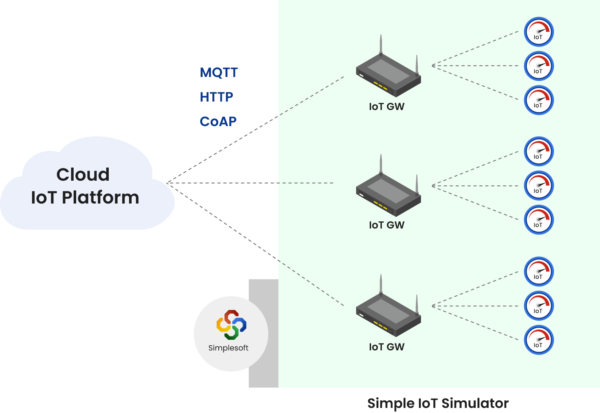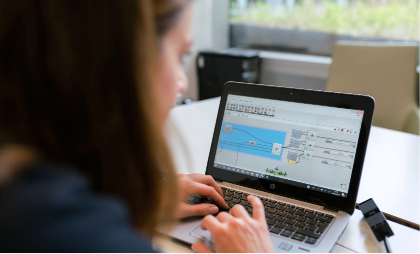
Overview
SimpleIoTSimulator® is an easy to use, IoT Sensor/device simulator that quickly creates test environments made up of thousands of sensors and gateways, all on just one computer.
SimpleIoTSimulator supports many of the common IoT protocols. They include
- LoRa Gateway receives LoRa frames (PHYPayload) from LoRa devices over UDP and encapsulates them into Semtech UDP Packet forwarder (Gateway Message Protcol-GWMP) packets or Semtech Basic Station (WebSockets) packets and sends them to a designated LoRa Network Server. Upon receiving downstream messages from Network Server, it extracts the frame payload and forwards it to the appropriate device over UDP.(application notes)
- LoRa Device currently supports both LoRaWAN 1.0.3 and 1.1 specification for Class A and C devices and transmits created LoRa frame (PHY Payload) to one or more associated LoRa Gateways over UDP. It supports activation by both Over-the-air-activation(OTAA) and Activation-by-personalization(ABP) methods for setting up security keys. The signal strength, signal-to-noise and channels can be specified when talking with specific gateways. The data payload can be modified by scripts to exhibit different sensor behavior.(application notes)
- CoAP sensors/devices to duplicate customer environments, or use the learnt data as a template to create thousands of sensors and gateways.
- MQTT is a publish/subscribe based protocol. Both MQTT ver 3.1 and ver 3.1.1 clients are supported and simulated sensors can be setup to periodically publish messages to a specified broker. A built-in learner utility is also included that subscribes to a broker and learns messages for subseqent replay.
- MQTT-SN is a variation of MQTT for Sensor Networks that has a more compact packet encoding. Like MQTT, simulated sensors can be setup to periodically publish MQTT-SN client messages to a specified broker and a built-in learner utility is included to learn messages for subsequent replay.
- MQTT-Broker receives MQTT subscribe requests from applications within the cloud/platform and sends publish messages to them. The simulator supports this functionality to simulate thousands of gateways. Optional bridging to another MQTT-broker in the cloud is also available. CoAP is an IETF proposed standard for retrieving and managing information for sensors and devices in a constrained environment. Using patented technology, the simulator can “learn” from existing
- HTTP/s client sends periodic XML/REST requests to cloud/platform servers. The simulator includes learner applications to learn http requests and periodically send them to specified servers for simulating thousands of gateways.
- HTTP/s server responds to incoming HTTP requests with responses. The simulator can be setup using learnt data for simulating gateways that support this functionality.
- Modbus over TCP encapsulates Modbus, the industry’s serial de facto standard since 1979, within TCP packets to enable communcation with automation devices. The simulator can “learn” from existing Modbus over TCP servers to duplicate customer environments, or use the learnt data as a template to create thousands of Modbus managed devices.
- BACnet/IP server responds to incoming BACnet unicast and broadcast requests with responses. The simulator can be setup using learnt data for supported objects and their properties. A few services (Who-is, I-am, ReadProperties, ReadPropertiesMultiple) are currently supported. A learner utility is also included.
SimpleIoTSimulator enables IoT platform and gateway vendors to improve product quality and significantly shorten their time-to-market without incurring large capital expense for creating test infrastructure. Both IPv4 and IPv6 sensors are supported and the simulator includes built-in support for lossy behavior in constrained environments. It can also create scripted error scenarios on demand. Example scripts to work with popular platforms like Azure IoT, Amazon AWS, IBM Bluemix and others are available to facilitate quick setup.
Operartion
Only a few simple steps are required to start using the SimpleIoTSimulator. They are:
- Use the built in MQTT, CoAP, Modbus, BACnet and HTTP learner utilities to record packet exchanges from real servers/sensors/devices.
- Use this learnt data as a template to create test environment with thousands of IoT sensors and gateways.
- Run scripts to create error scenarios, and dynamically change properties.
- Support for changing data is built-in without requiring any user programming as is lossy behaviour and delay.
- If support is also needed for other management protocols like SNMP, Telnet, SSH, an IoT management module is available within the popular SimpleAgentPro and SimpleAgentEnterprise.
Applications
- Sales groups can create realistic demos that highlight the management application features to shorten sales cycles.
- Development and QA groups can do scalability and functional testing without large test infrastructure.
- Professional services can create targeted services using duplicated customer environments.
- Tech Support departments can more easily reproduce customer problems in their test labs.
- Sensor data changes can be modelled to create different physical environments.
- Simulate LoRaWAN networks to demonstrate and test User Application Software and LoRa Network Servers (application notes). Can be used by both LoRa Network Service Providers and their customers.
Availability
Please email sales@simplesoft.com for trial or purchase.
System Requirements
- 64-bit Linux: RedHat versions 5, 6 and 7; Ubuntu versions 16 and 18; CentOS versions 6 and 7.

SimpleSoft - an Industry Leader
Resources
- Video
- Product Updates
- Blogs
- White Paper
SimpleSoft Network Simulator Overview
SimpleSoft Agent Tester Overview
SimpleSoft SimpleIoTSimulator Overview
SimpleSoft releases Version 27.5 of SimpleAgentPro/Enterprise
SimpleAgentPro/Enterprise 27.5 now GetBulk based, faster learning, include file support in Telnet modeling files to reduce duplication, automatic handling of filters in Cisco IOS CLI commands,…
Release Notes
December 20, 2023
SimpleSoft releases Version 27.0 of SimpleAgentPro/Enterprise
SimpleAgentPro/Enterprise 27.0 now supports common data representation of variables for use by many management protocols, saving of configuration command information during CLI provisioning, simplified GPB buffer specification for Telemetry, Modeling file debugger,…
Release Notes
June 29, 2023
SimpleSoft releases Version 26.5 of SimpleAgentPro/Enterprise
SimpleAgentPro/Enterprise 26.5 now supports performance statistics in Netconf, provides remote host/port information in Telnet/SSH for filtering, allows timer_action to be staggered in SNMP,…
Release Notes
December 20, 2022
SimpleSoft releases Version 26.0 of SimpleAgentPro/Enterprise
SimpleAgentPro/Enterprise 26.0 now enhances Telemetry support in HTTP2/client and HTTP2, adds valuelist support in Netconf data modeling, AES-192-C and AES-256-C support for Cisco key initialization in SNMP,…
Release Notes
July 29, 2022
SimpleSoft releases Version 25.5 of SimpleAgentPro/Enterprise
SimpleAgentPro/Enterprise 25.5 now adds enhanced Netconf support for data modeling and namespaces, improved Telnet config command score handling, HTTP/2 server response generation without data,…
Release Notes
December 14, 2021
SimpleSoft releases Version 25.0 of SimpleAgentPro/Enterprise
SimpleAgentPro/Enterprise 25.0 now includes support for HTTP/2 client for dial-out telemetry with gRPC, exporting and importing of maps, device diagnostic connectivity checking, support for a config command score to give different show command responses after config changes in Telnet/SSH,…
Release Notes
July 27, 2021










